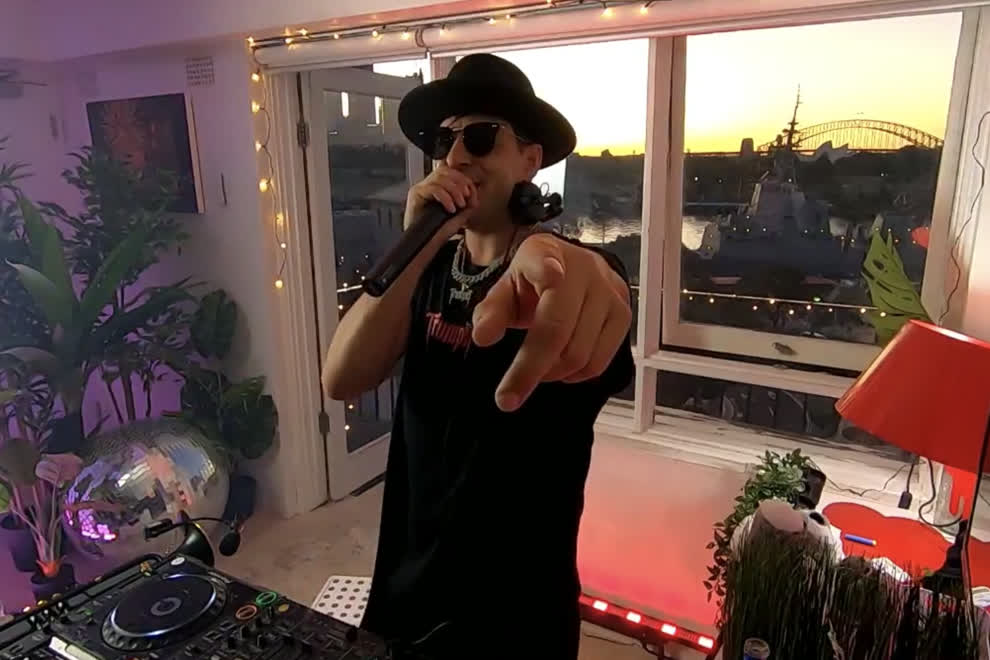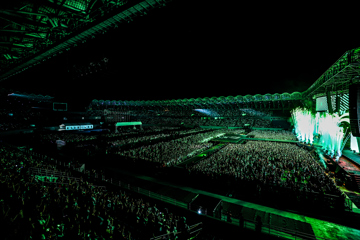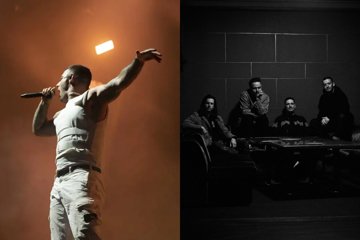Livestreaming & Virtual Concerts Are Making Money, But Is Australia Missing Out?
"They missed the bus with not recognising that there are many music fans that are unable to travel due to age, disability and location..."

Timmy Trumpet's 2020 live-stream (Credit: Isol-Aid)
Livestreamed shows and VR concert experiences were generally viewed as stop-gaps during the pandemic lockdowns, and discarded as soon as concerts and festivals put out their “back in business” tags.
But there is an upsurge in interest, notably from Gen Z live music fans.
Australian promoters, though, remain cautious about adopting it, citing ongoing challenges. Two told The Music they might introduce it down the track, but have no current plans.
However, a digital pioneer has urged the local live sector “not to miss the bus” this time and suggested that governments help bring production and virtual ticket prices down.
The scenario is different in the northern hemisphere.
In August, the Belgian EDM festival Tomorrowland’s TikTok livestream drew over 74 million viewers across its two weekends. This was a 362.5% jump from the 16 million who watched it on TikTok in 2023.
Don't miss a beat with our FREE daily newsletter
A TikTok executive remarked, “Electronic music is one of the biggest genres on TikTok, and Tomorrowland is a truly unique experience that showcases electronic music in all its glory.”
Such is EDM’s dominance on TikTok that content tagged with #electronicmusic has reached 36 billion views.
Between July 4th and 19th, Switzerland’s legendary Montreux Jazz Festival saw global live stream views up 324% from 2024. The viewing was made more compelling by acts performed before a picturesque backdrop of the Swiss Alps reflected on Lake Geneva.
Its YouTube spectators surpassed 2.5 million, with 7.5 million on all social platforms. Fifteen concerts were broadcast free on the Montreux official YouTube channel. Artists included from Chaka Khan, J Balvin, FKA twigs, Rüfüs Du Sol, Royel Otis, Benson Boone, Joe Bonamassa, RAYE, and Alanis Morissette.
Fortnite
Virtual concerts on Fortnite – names have included Ariana Grande, Snoop Dogg, and Metallica – also draw in the numbers.
Fortnite’s Remix: The Finale virtual concert from November 2024 attracted 14.3 million concurrent players, breaking Fortnite's in-game concert records.
According to a report, “The 15-minute spectacle also reached an estimated 3 million additional viewers through live streams, making it one of the most impactful digital gatherings in recent memory.”
It went on to say: “For event organisers, Fortnite's success is more than just impressive statistics—it signals a transformation in how audiences interact with entertainment.
“Virtual events are no longer niche experiments but mainstream experiences capable of rivalling or surpassing traditional in-person events in scale and impact.”
For Coachella 2025 in April, it drew 125,000 a day. It had 41 million views on its online stream, making it the most livestreamed event ever. 160,534 alone watched it on Coachella’s official YouTube channel, with more than half the spectators from outside the US for the third year.
Watchers from home had the luxury of accessing four stages simultaneously via a click on their remote and avoiding having to run across the large site to see all the acts they wanted.
Plus, they could escape the heat, long queues and overpriced meals of the real thing.
Brazil's views doubled, Mexico’s jumped fivefold, India’s increased 900%, and Korea’s increased 1,400%. The festival has accumulated more than 1 billion YouTube views.
It was money-making for the major stars involved in 2025. Lady Gaga, the star of the event, saw her weekly stream rate jump 27% to 26.3 million from 20.6 million the week before, and she earned five spots on two Billboard global charts, clearly related to worldwide streams.
Two of her best-known hits, Poker Face and Bad Romance, reached their highest-ever chart positions, an indication of how she picked up new global fans as a result of livestreaming.
Charli XCX, joined by Lorde and Billie Eilish, had a 27% jump, to 12.7 million extra streams in the U.S., Green Day was up 17% with 10 million streams, and Post Malone grew 5% to a catalogue total of 30.3 million.
Livestreaming has become so crucial to some major festivals that acts turn their sets into beaches or castles for visual impact, put in high production, and specifically link their social media followers to the livestream.
US festival programmers are widening their bills to include overseas acts, including those from Australia. For instance, Coachella 2026, which is already booked out, has Royel Otis, The Chats, Ecca Vandal, and Ninajirachi.
Large Scale
Live streaming on a large scale in Australian festivals is still a way.
One top promoter whose live events sell over a million tickets a year, admitted, “It’s not a priority. There are significant opportunities, but these come with a number of complications because it’s untapped in the Australian live industry.
“One is in terms of quality control, and which artists will be comfortable with. But with ticket prices as high as they are and not affordable to everybody, there are hopefully ways to bring the live concert experience to a far wider audience.”
Another high-ranking promoter agreed that quality control was still a dilemma, adding, “It’ll take time to get the quality right.” Also suggested to The Music, “IP is an issue, and copyright issues with acts.”
However, a new trend in the northern hemisphere, which could be repeated in Australia, might speed up plans.
According to the US research company Luminate, after the first rush of excitement to experience live music, fewer Gen Z males are attending.
For the first time, Gen Z women have outpaced men in physical concert attendance. So far, it’s only by a small margin of 3% to 6% but it’s a trend that could change the landscape, given that 10% of females intended to go to concerts through two surveys in 2024.
It could mean changes in programming (more female-led pop?) and merch design, for instance.
But promoters starting to worry about the loss of income from a dip in Gen Z males would see virtual shows as a solution.
According to Luminate’s U.S. Music 360 survey for Q1 2025, conducted in June 2025, almost half of American Gen Z men see livestreamed performances as a good way to connect with an artist they like. This is compared to 39% of the general population.
Additionally, 38% believe a hologram or VR concert is an exhilarating way to engage with an artist (vs. 25% of the general population).
These also go down a storm with Superfans, of course. As it is, 59% of American Superfans and 72% of global ones indicate they’d pay for a virtual show, as it’s a way to support their heroes, especially if perks like virtual meet-and-greets or song requests are offered.
South Korean entertainment HYPE has cashed in on its Super Fan app, Weverse.
In 2020, when K-pop superstars BTS were about to take a break to do military service, a farewell concert livestream drew 49 million viewers and grossed US$44 million (AU$66.5 million).
On March 6 this year, a solo 12-hour Sweet Dream Live livestream from BTS’ J-Hope snared 26.9 million viewers and a total of 226 million likes, and earned $4.1 million (AU$6.29 million) in one night globally.
These were better numbers than the Grammys (15.4 million views), the Oscars (18.1 million), the American Music Awards (12.9 million), the Billboard Music Awards (12.9 million), the Golden Globes (10.1 million), and the MTV Video Music Awards (4 million).
On July 14th, the band’s Jungkook’s livestream on the platform, a month after his military service ended, drew 10.9 million fans.
Cover Bills
Some did make enough money from digital viewing options to cover bills during the pandemic shutdown around five years back.
Charging $15 per session and selling 1,800 tickets could mean $27,000. Some platforms set up features that let fans add tips. Other artists found they could earn up to $60,000 per session.
There were some creative successes in Australia. One was Isol-Aid, a free livestreaming festival set up by music industry figures Rhiannon Atkinson-Howatt (aka the artist Merpire), singer-songwriter and booker Emily Ulman, and One Of One agency founder Shannen Egan.
It started as a one-off in March 2020 to raise money for Support Act through viewer donations with 72 artists. It raised over $12,000. It continued to its eighth installment, bringing the total number of artists showcased to 449 and winning a number of awards along the way.
A notable event was Timmy Trumpet’s one-hour stream from his Sydney apartment, which drew about 1.4 million views on social media from 60 countries.
So was Byron Bay’s The Buckleys, whose virtual global tour consisted of 18 shows covering North America, South America, Europe, the Middle East, Asia, Australia, and New Zealand on Live Nation’s Live From Home platform. It reached 4 million viewers, Live Nation said.
But the Australian live industry failed to take advantage and missed the bus, suggests Adelaide-based tech pioneer David Grice.
Just before COVID-19, Grice was part of a consortium behind a start-up, Netgigs, on a live streaming platform that sat behind a paywall.
Artists would determine the ticket price. Those who couldn’t attend or had disability/mobility issues could buy a virtual ticket. They could watch in real time, or within a 24-hour period, for those in different time zones.
Netgigs was registered with royalty collection agencies around the world, including APRA AMCOS and ASCAP.
Relates Grice, “When COVID hit, the founder worked extremely hard to convince promoters and artists to live stream socially isolated gigs, so they had a means of income through that time.
“As people were locked down, it was hoped that the ability for artists around the world to make money from a livestreamed virtual concert (when none were able to take place) would still mean artists could survive through what was the most difficult period in recent history.
“When live gigs were able to begin again, the system was geo-blocked to ensure the artist had control of what regions could have access to tickets.
“That meant that those in the city where the concert was being played would be geo-blocked for that area, and live streaming ticketing would be open to cities and states not local to where the gig was.”
Grice says the live industry blocked Netgigs and other livestreaming services because it would cannibalise physical shows as they returned.
They didn’t realise there would have been extra revenue from virtual tickets and from fans from overseas. A band that played a sold-out physical show to 2,000 but had the capacity to reach an extra 5,000 or 10,000 while maintaining the same production costs.
“They missed the bus with not recognising that there are many music fans that are unable to travel due to age, disability and location, and a system like Netgigs could have enabled those fans to be included.”
Gen Z’s boosted interest should be followed up on in Australia to make it a creative and financial payout, Grice urges.
“To make it more of an experience, technology and the artist must be able to place the viewer in a particular spot in the audience that will give the viewer a more immersive view, with an experience that is more than just an image on a flat screen.
“Things like access to backstage shenanigans, artist interviews, or exclusive live chat Q and A with the artist and the like would also enhance the virtual experience, which was what Netgigs had already tested and proven.
“The music industry must realise that streaming can be a tool to maximise revenue from a single performance that previously doesn’t currently exist. Whoever gets on it early will win.”
Government aid would be instrumental, he stresses.
“But the Government in general isn’t too concerned with any creative industries as much as it was 10 years ago.
“Government funding to enable entrepreneurs would be welcome, but I’m sure it will be difficult for any streaming service to gain access to Government assistance for development costs or streaming platform charges to make it more affordable for artists to stream.”







